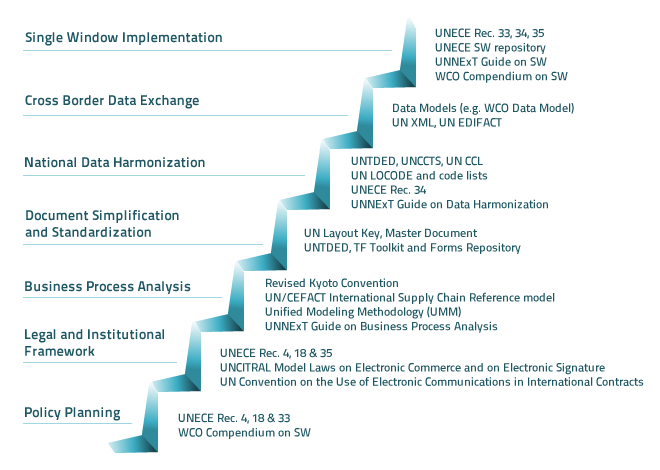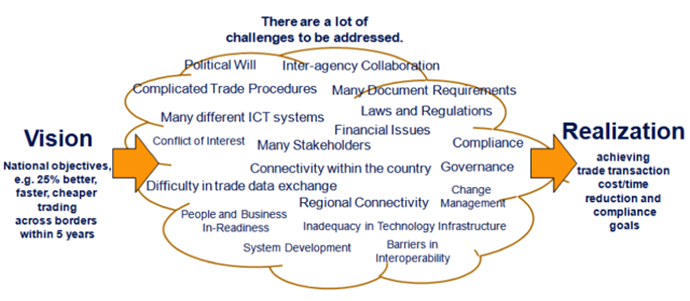Step 5. Understand better the preconditions and success factors of a Single Window project.
Single Window implementation
The establishment of a Single Window is a major political reform project. Contrary to broad understanding it is not foremost an IT project. It is a change management project, that encompasses multiple agencies and other partners, involve some form of business process re-design, document simplification and data harmonization. The duration from the initial idea to the actual functioning of a SW can be long as the project includes several implementation phases.
Individual aspects of the implementation
Individual aspects of the implementation include, policy planning, setting the legal and institutional framework, undertaking a business process analysis, simplifying trade documents, organizing the data harmonization for the Single Window, and managing the project, as shown in Figure 3. This is a multi-year incremental project. A successful undertaking also requires strong business-government cooperation.

Source: UNECE- UN/CEFACT
Policy planning
The establishment of a Single Window system is a complex political reform project. While it is well recognized as an enabling tool for easing trade across borders, policy makers will confront many challenges and obstacles when transforming the vision and goals of a Single Window into reality. Several challenges in Single Window planning implementation, as shown in Figure 4, concern both technology issues and areas such as political support, long-term commitment from top management, a reliable institutional platform for inter-agency collaboration, effective management of stakeholders’ expectations and perceptions, workable business procedures, architectural models, data and business interoperability, laws and regulations, and financial issues. Policy makers and managers need a strategic and holistic framework that helps them to systematically address such challenges and to effectively manage the Single Window project.
Tools: This process needs careful steering. The UNECE Recommendation No. 33 provides useful guidance, in particular with regards to the organization of the preparatory work. It introduces the various policy documents that may have to be developed and provides further detail on their contents. Volume 1 of the WCO Single Window Compendium also introduces the various aspects that have to be taken into consideration in the policy and project management. UNECE Recommendation No. 4, Recommendation No. 18 and Recommendation No. 40 outline the framework for the necessary trade government collaboration.

Source: UNNExT SW project Implementation Guide
Legal and institutional aspects
National exchange of trade data amongst the participating parties of a SW requires a legal framework that enables and defines the conditions of, amongst others, the electronic submission of documents, electronic signatures, data sharing and data archiving. UNECE Recommendation No. 35 and the WCO Single Window Compendium identify the following legal issues that arise with a Single Window implementation: Privacy and data protection issues; Sharing of access to data and sharing of data amongst agencies; Liability issues; Data quality; Electronic documents and archiving; and Identification, Authentication and Authorization.Legal issues also relate to the operation of a Single Window. This include aspects such as setting up the legal authority for the operation of the Single Window, defining the legal basis of agency cooperation through, e.g. MOUs amongst the participating agencies, and defining dispute resolution between the Single Window parties. The Thai National Single Window project offers a good example of a successful interagency collaboration framework.
Tools: UNECE Recommendation No 35 and its checklist provide guidance for an analysis of the current legal framework and necessary changes . UNCITRAL has developed significant supporting legislative texts comprising the UNCITRAL Model Law Electronic Commerce (1996), the Model Law on Electronic Signatures (2001), the UN Convention on the Use of Electronic Communications in International Contracts (2005), and a Guidance Text on the International Use of Authentication & Signature Methods. UNNExT also provides a Legal Guide for Electronic Single Window and Paperless Trade
Business Process Analysis
The establishment of a Single Window for Trade requires the design of new services and changes to agencies’ and other stakeholder business processes. Undertaking a Business Process Analysis (BPA) is useful step and tool for the design of the Single Window. It allows all parties involved in the reform effort to gain a better understanding about the documentary, procedural and operational aspects of international trade transactions. In particular, it informs how business processes are carried out, how business processes relate to one another, who is responsible for generating them, and what documents, rules, and regulations are involved and how this information flows.
Tools: the BPA chapter of this Guide, the UNNEXT Guide on BPA, and the chapter on BPA in the UNNEXT Guide on the SW Implementation Framework (SWIF) provide useful guidance.
Document simplification, data harmonization and cross border information exchange
Full scale Single Window operation involves information sharing, integration and exchange among stakeholders of the international supply chain. In order to ensure interoperability, each Single Window’s component has to employ common rules that govern data element names, their meaning, their representations, and the structure of electronic messages. Ideally they should employ a single set of generic semantic rules or data model. Data harmonization can be conducted as a sub-project of the Single Window project. In order to achieve data interoperability a number of international standards and tools are necessary. UNECE and its Centre for Trade Facilitation and Electronic Business (UN/CEFACT) and other organisations, such as the WCO, have produced key standards for this component of a Single Window project, including:
- the UN Layout Key to align documents to international standards,
- the UN Trade Data Elements Directory (UNTDED) and the UN Core Component Technical Specifications (UNCCTS) to define data using standard semantic,
- Codes for Trade Data, including the LOCODE, codes for means of transport, codes for payment terms, etc.,
- Data Models to develop applications needed for data interoperability across platforms and to design electronic documents such as the UN Core Component Library (UNCCL) and the WCO Data Model,
- Standards to obtain the structure of electronic documents and messages such as UN XML NDR, EDIFACT MIGs, WCO EDIFACT MIG/XML Schemas.
Tools: UNECE Recommendation 34 provides a step by step approach to data harmonization that can be implemented by a national team of experts. The UNNExT Guide on Design of Aligned Trade Forms and the UNNExT Data Harmonization and Modelling Guide is a useful reference for data harmonization as part of a Single Window implementation process.The WCO has developed the Single Window Data Harmonization Guide.
